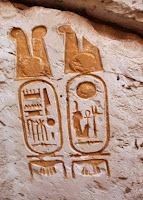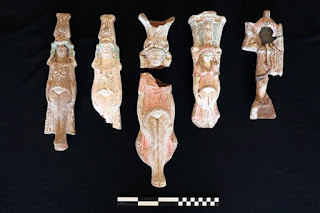Monday, November 25, 2019
Ancient Egypt News 11/25/2019
Cleopatra VII: Scholar, Patron, Queen
Photo: The British Museum
Alexander the Great conquered Egypt in 332 BCE, altering the political panorama of the eastern Mediterranean and the ancient Near East for the centuries to come. One of Alexander's generals, Ptolemy Lagos, identified Egypt as one of the richest areas of Alexander’s empire. He first served as regent for Alexander’s half-brother, Philip, and his son, Alexander IV, but soon took over the throne himself, inaugurating a new dynasty that would endure the next three centuries. All the subsequent kings in the dynasty bore the name Ptolemy after Ptolemy Lagos, distinguishing themselves with different epithets.
As notable as the Ptolemaic kings were the queens of the period. The queen whose memory has persisted as the most notorious character of this period after Alexander himself is Cleopatra VII. The daughter of Ptolemy XII, Cleopatra ruled as the last monarch of the dynasty before Egypt became a province of the Roman empire.
Digging into Ancient Egyptians' Fascinating Coffins World
While the ancient Egyptians believed in the sanctity of afterlife, their coffins expressed those beliefs in the most heart capturing, mesmerising way. The Pharaonic coffins' alluring colours, the sharpness of their details, and their perfectly shaped designs summed this civilisation's glorious eminence.
With the aim of presenting a deeper look into the world of fascinating ancient Egyptian tombs, the Bibliotheca Alexandrina (BA) held a workshop for 40 museum curators and conservators. Under the title 'Understanding Ancient Egyptian Wooden Coffins', the workshop provided participants with a practical training on the examination, carpentry, and construction of ancient coffins.
Photography’s Potential as Art and Science in Documenting Ancient Egypt
John Beasley Greene (1853) the Metropolitan Museum of Art, New York
Signs and Wonders: The Photographs of John Beasley Greene features photographs that focus on ancient monuments and landscapes in Egypt and Algeria from the 1850s, rather than people.
Ancient Egypt has turned up in some unexpected museum exhibitions this year. First, there was the Pulitzer Arts Foundation’s Striking Power: Iconoclasm in Ancient Egypt, followed by the Freud Museum London’s exhibition on Freud’s fascination with Egypt. Now the San Francisco Museum of Modern Art has opened Signs and Wonders: The Photographs of John Beasley Greene, featuring photographs of ancient monuments and landscapes in Egypt and Algeria from the 1850s.
For more on this artist, see The Strange Emptiness of Egypt in 19th-Century European Photographs.
Archaeologists Discover Hidden Palace Marked With Symbols Of Ramesses The Great
An Egyptian palace was discovered on the same site as Ramesses II’s adjacent Temple by New York archeologists.
The palace and temple are located at the ancient site of Abydos, Egypt, where numerous kings are also buried.
Archaeologists were excavating in and around the temple when they discovered the palace
Ptolemaic-era Temple Discovered in Sohag
Photos by Mahmoud Khaled and Mohamed el-Shahed AFP
Archaeologists have discovered a 2,200-year-old temple in Egypt. It is believed to belong to Ptolemy IV Philopator of the Ptolemaic Kingdom.
The structure of the ancient cemetery was found by chance as excavators supplied sewage lines to the village of Kom Ashqaw in the city of Tama, north of Sohag, according to the Egyptian Ministry of Antiquities' posts on its official Facebook page.
Egypt Officially Criminalizes Climbing the Pyramids
Pyramids (via Divya Thakur’s Flickrstream)
Under new articles in the country’s antiquities protection law, climbing monuments and smuggling antiquities out of the country will result in high fines and jail sentences.
https://hyperallergic.com/528576/egypt-officially-criminalizes-climbing-the-pyramids/
Egypt’s parliament amended its antiquities protection law to impose tougher jail sentences and higher fines for smuggling antiquities out of the country, and for the first time criminalizes climbing the country’s monuments.
Khufu Ship: Five Things You Didn’t Know About Egyptian Pharaoh’s Vessel Buried With Him
The discovery of the Khufu ship – an ancient Egyptian pharaoh’s barge buried inside his funeral pyramid – in 1954 was celebrated by a Google Doodle on May 26th.
The wooden ship is 4,600 years old and was reportedly so well-designed it could still sail if launched back onto the Nile today.
Literary Egyptomania: Eight Authors Who Found Inspiration in Egypt
Source: https://egyptophile.blogspot.com/
https://egyptianstreets.com/2019/11/17/literary-egyptomania-eight-authors-who-found-inspiration-in-egypt/
rom movies to best-stelling novels, it’s easy to conjure a list of authors, filmmakers, photographers and artists who have found inspiration in the coutry’s ancient and modern cultural heritage.
While it may comes as a surprise for many, authors in particular, have always had a fondness for writing about Egypt while chronicling their travels sailing the Nile and visiting archeological sites.
Egypt’s undeniable impact on the cultural imagination of Western cultures eventually sparked waves of ‘Egyptomania’ , a term coined in allusion to the specific flourishing and renewed interest in ancient Egypt after Napoleon’s ‘Egypt’ campaign took place in the 18th-19th century.
Photos: The Egyptian Museum celebrates its 117th anniversary
The Egyptian Museum celebrated its 117th anniversary on Friday with a ceremony attended by Minister of Antiquities Khaled al-Anany, the Governor of Cairo, five current and former ministers, and 40 foreign and Arab ambassadors.
Magnificent Egyptian Catacomb Reveals Carvings of a 'Worthy' Woman and Her Pet
Image credit: Egypt Ministry of Antiquities
Almost 2,000 years ago, at a time when the Romans ruled Egypt, a woman named "Demetria" was laid to rest in a magnificently decorated catacomb at Saqqara in Egypt.
A carving found in the underground tomb appears to depict Demetria wearing an elaborate dress while carrying grapes. Some sort of pet looks up at her, with two of its paws on her dress.
Subscribe to:
Post Comments (Atom)




![John Beasley Greene, “Pyramids of Giza, [Mr. Mariette’s site], Excavation to the left of the Sphinx” (1853) John Beasley Greene, “Pyramids of Giza, [Mr. Mariette’s site], Excavation to the left of the Sphinx” (1853)](https://blogger.googleusercontent.com/img/b/R29vZ2xl/AVvXsEiiOVE2ToJMxpe5om_wDoEPPTuV0cxvTHmV89TPTI4UGDHPb57idVFfCTGDRGgh9au8fprOzthd5PfFgrpd2GHHsGF64YP_n1SYJfZ8y5qOKlohg0151xH5ODrMSatsjzj0Vfpt15CYsNyE/s320/4-Mariette-Michael-Press-SFMOMA-720x558.jpg)







No comments:
Post a Comment
Note: Only a member of this blog may post a comment.